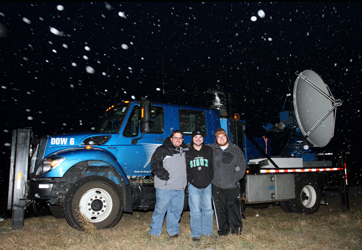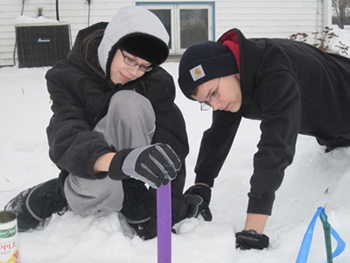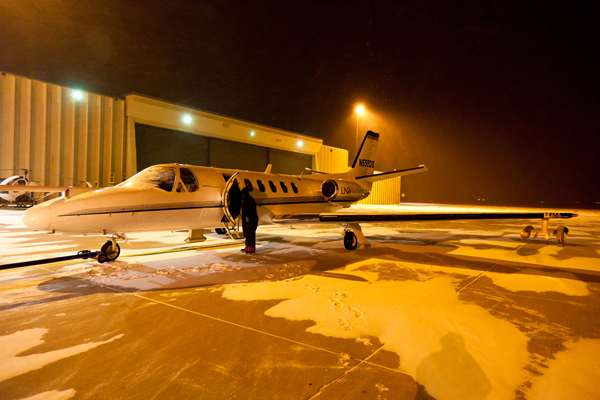A different kind of snow day
K–12 students join winter weather study
Mar 10, 2011 - by Staff
Mar 10, 2011 - by Staff
11 March 2011 • Snowstorms have been a dime a dozen across much of the central and eastern United States over the last few months, but four of them got special scrutiny. These bouts of winter weather were tracked by three radars, several university scientists, and more than 200 schoolchildren in a student-oriented field campaign last November and December across eastern North Dakota and western Minnesota.

Darkness didn’t keep UND graduate students Brandon Bigelbach, Joel Siegel, and Aaron Kennedy from deploying a Doppler on Wheels unit on 19 November 2010 during one of SNOwD UNDER’s four storms.(Photo by Justin Walker, Center for Severe Weather Research.)
More than 40 graduate and undergraduate students at the University of North Dakota steered the planning and execution of the SNOwD UNDER project (Student Nowcasting and Observations with the DOW at UND: Education through Research). Along with giving students a taste of field work, the project should help strengthen the ability to estimate snowfall amounts from radar data. “Snow is really difficult to measure accurately,” says Aaron Kennedy, who coordinated the field phase with fellow UND graduate student Andrea Neumann.
UND’s Matthew Gilmore, who developed the idea for SNOwD UNDER, wove the project into the radar meteorology course he taught in the fall semester, and fellow UND faculty Leon Osborne and David Delene brought other classes into the fold. “We already have our own radar and a local NEXRAD radar, so we decided this would be an ideal time to try a triple-Doppler study,” Gilmore says. Data from the polarized UND and DOW radars will be compared to ground measurements and data gathered by UND’s Citation aircraft.
Smoothing the project’s way was a newly simplified process at NSF for requesting use of the Doppler on Wheels radar for smaller education-oriented projects. “Many students gained experience operating the DOW and other sophisticated instrument systems,” says Joshua Wurman, who manages the DOW fleet at the Center for Severe Weather Research. “The project was a success in both its education and research goals.”

Luke and Ben Hartman, home-schooled students in Minnesota, measure the day’s accumulation for SNOwD UNDER on 5 December 2010. (Photo courtesy Sara Hartman.)
With the Dakota Science Center serving as liaison, UND staff worked with students at nine elementary, middle, and high schools and one other university (Mayville State) to gather data for SNOwD UNDER. The student observers were trained in placing and using snowboards (flat plates that are swept at regular intervals to obtain precise accumulations) provided by the firm Ecolab. Middle and high school students also melted snow to calculate its density.
In a happy coincidence, SNOwD UNDER took advantage of flights on the Citation that were supported by Goodrich Sensors and Integrated Systems in order to test an optical ice conditions detector. “We also had nature on our side with four storms in three weeks,” adds Gilmore. “We were very busy and very lucky compared to many field projects I’ve been in.”

The University of North Dakota’s Citation aircraft made several forays into winter storms for SNOwD UNDER. (Photo by Zhe Feng, UND.)